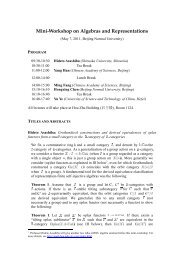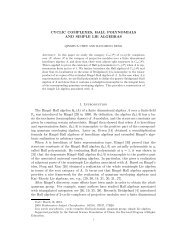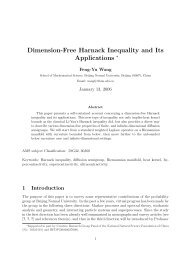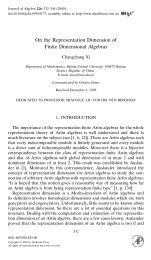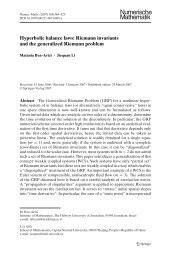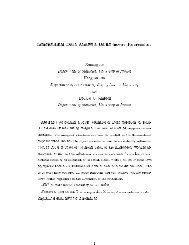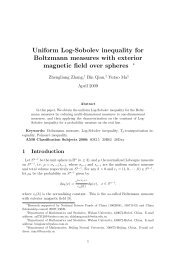Fourier Spectral Moving Mesh Method for Willmore Equation of ...
Fourier Spectral Moving Mesh Method for Willmore Equation of ...
Fourier Spectral Moving Mesh Method for Willmore Equation of ...
Create successful ePaper yourself
Turn your PDF publications into a flip-book with our unique Google optimized e-Paper software.
area is not unchanged. Since we have no requirement <strong>for</strong> the boundaries, we cannot assumethe physical area is an unit square. Hence, it’s hard to propose the boundary conditions <strong>for</strong>the Navier-Stokes equations. I have some ideas as follows:In order to <strong>for</strong>ce an unit square we need to <strong>for</strong>ce the displacement dx(x, y)| ∂Ω = 0 aswell as dy(x, y)| ∂Ω = 0. But we also require both dx and dy are periodic. And dx, dy arethe solutions <strong>of</strong> the MMPDEs. Hence, we cannot guarantee the existence <strong>of</strong> such a solution.And I need your suggestion on such issue.Another problem is about the semi-implicit scheme. Let’s review the equation(1 + ξ(λ ∗ κ 2 ) 3 δt)(ˆ¯φ − ˆφ) = δt{ ˙⃗x · ∇x φ + ξ∆ 3 φ − 1 ξ ∆2 W ′ (φ) − 1 ξ ∆(∆φW ′′ (φ)) +∫1ξ ∆(W ξ′(φ)W ′′ (φ)) + M[3 Ω 2 |∇φ|2 + 1 4ξ (φ2 − 1) 2 dx − β](−ξ∆ 2 φ + 1 ξ ∆W ′ (φ))} ∧I remembered in Hangzhou you told me that the splittingu t = a max ∆u implicit + (a(x) − a max )∆u explicitwill enhance the the stability. Hence I’m not surprised to see such a splitting scheme, whichutilized ∆ x φ = 1 ∇ J ξ · (JA∇ ξ φ) and it is some what like the splitting scheme above. And myquestion is that, why would such an semi-implicit scheme more stable? I use such a schemeover and over again, but I don’t know why? I failed to think it out. Is there some papers torefer to? Or would you mind explaining it to me?7 AppendixThe <strong>for</strong>mulas in this paper have been cited many times,and here we give the detailed pro<strong>of</strong>.a i = 1 J a j × a k , a i = Ja j × a k , a i · a j = δ i,jJ = a 1 · (a 2 × a 3 )Pro<strong>of</strong>:First <strong>of</strong> all, by the definition <strong>of</strong> Jacobian Matrix it is obvious that J = a i · (a j × a k ) as longas i, j, k are in right hand order.Secondly, using the fundamental <strong>of</strong> inverse function, we have a i · a l = δil14




